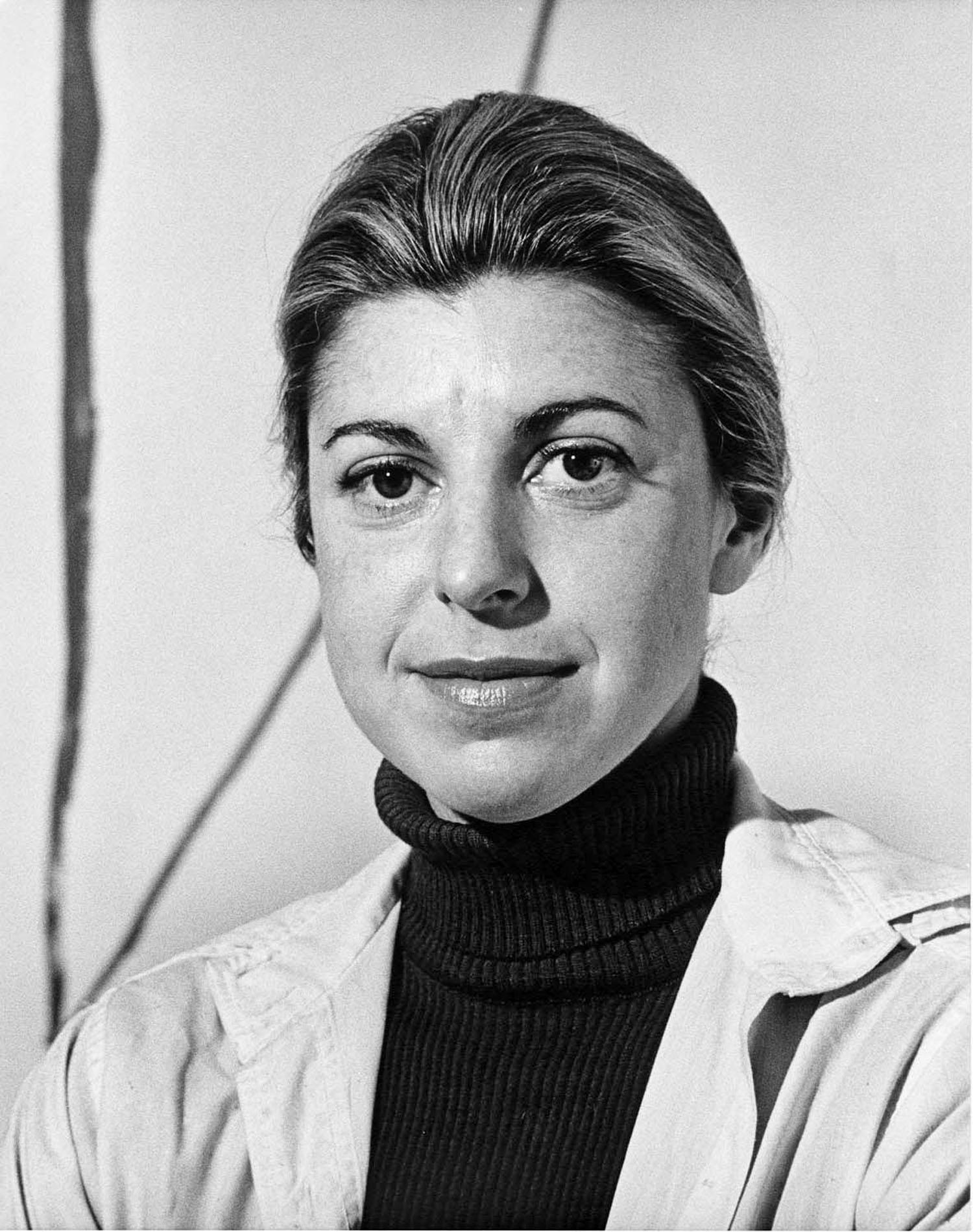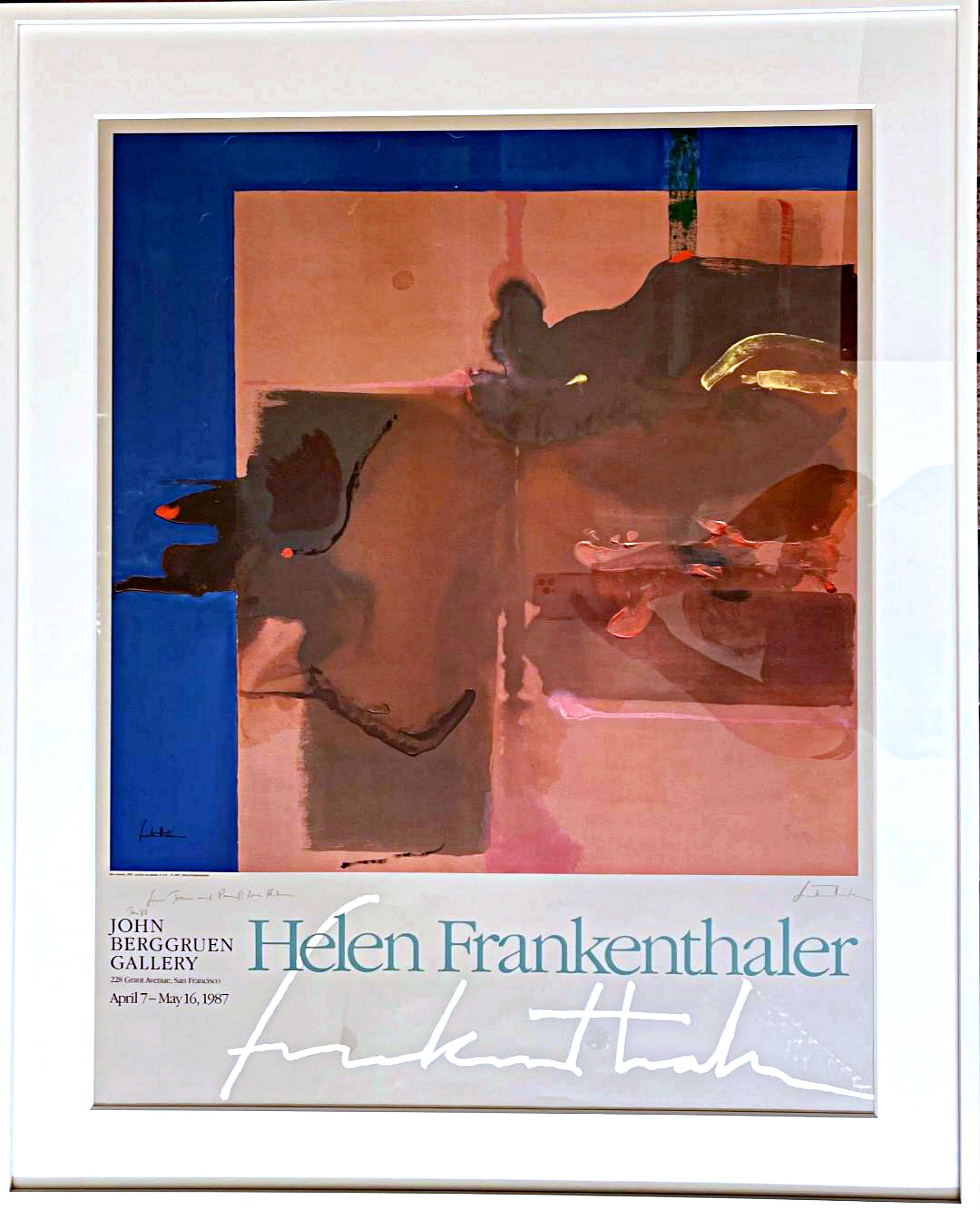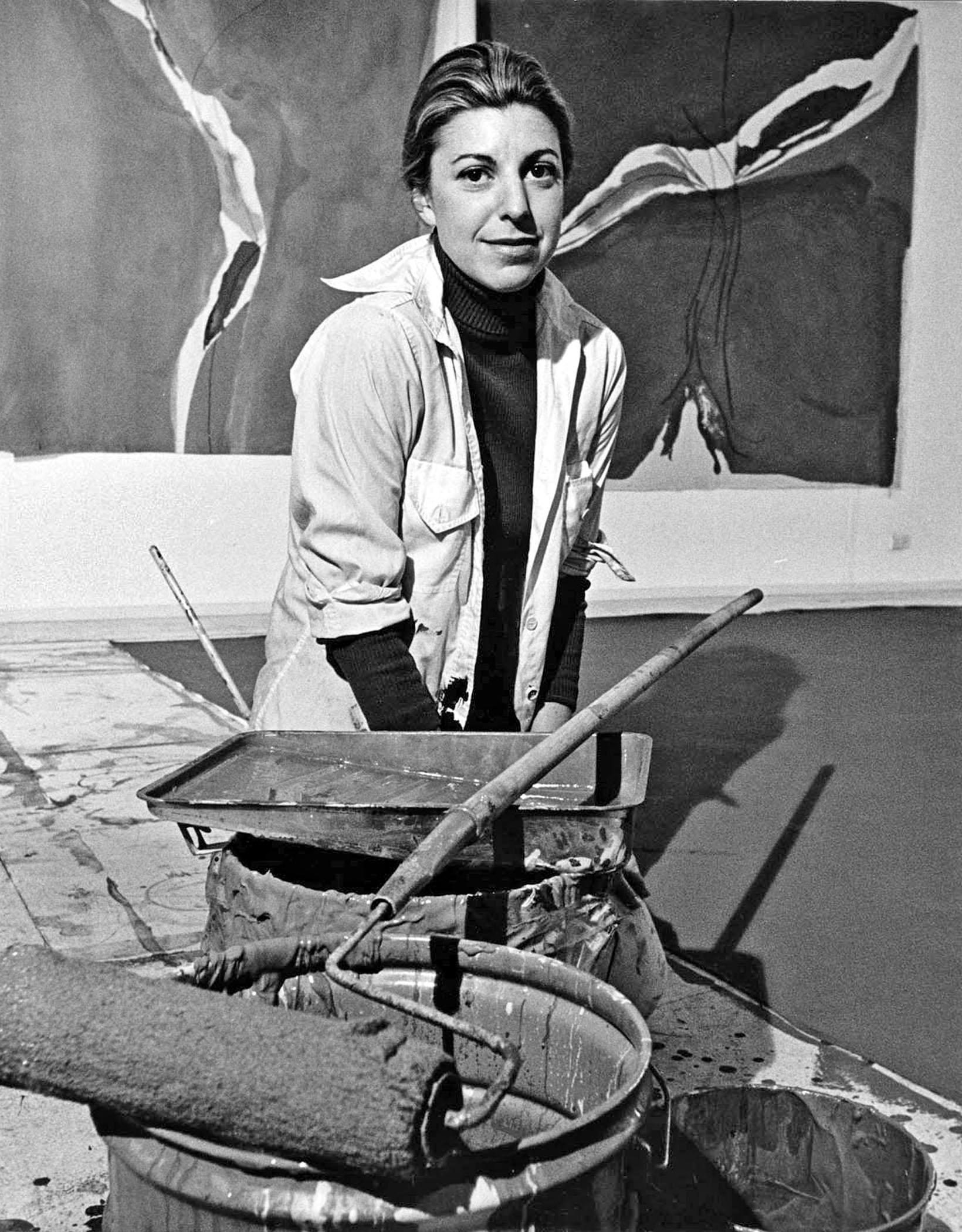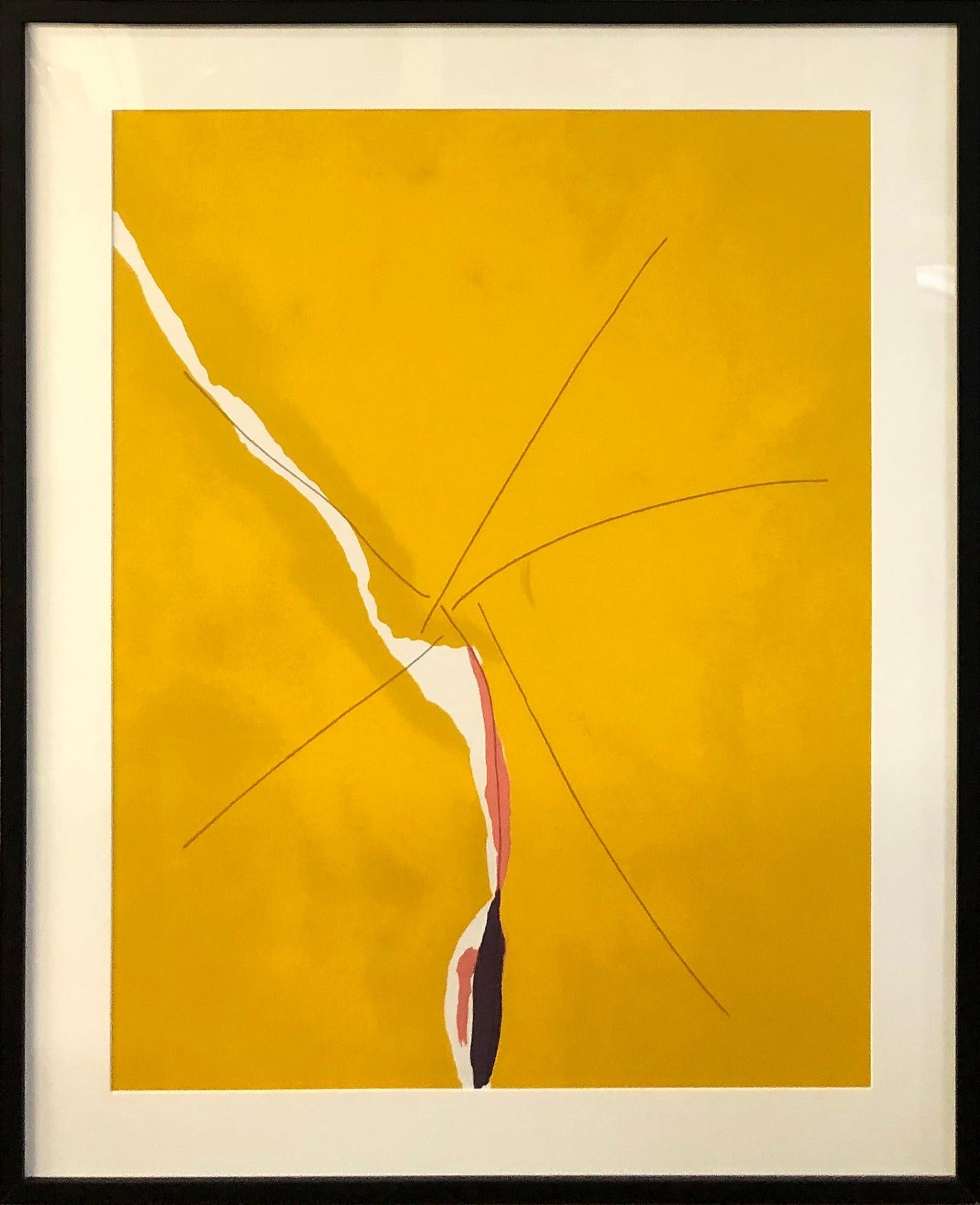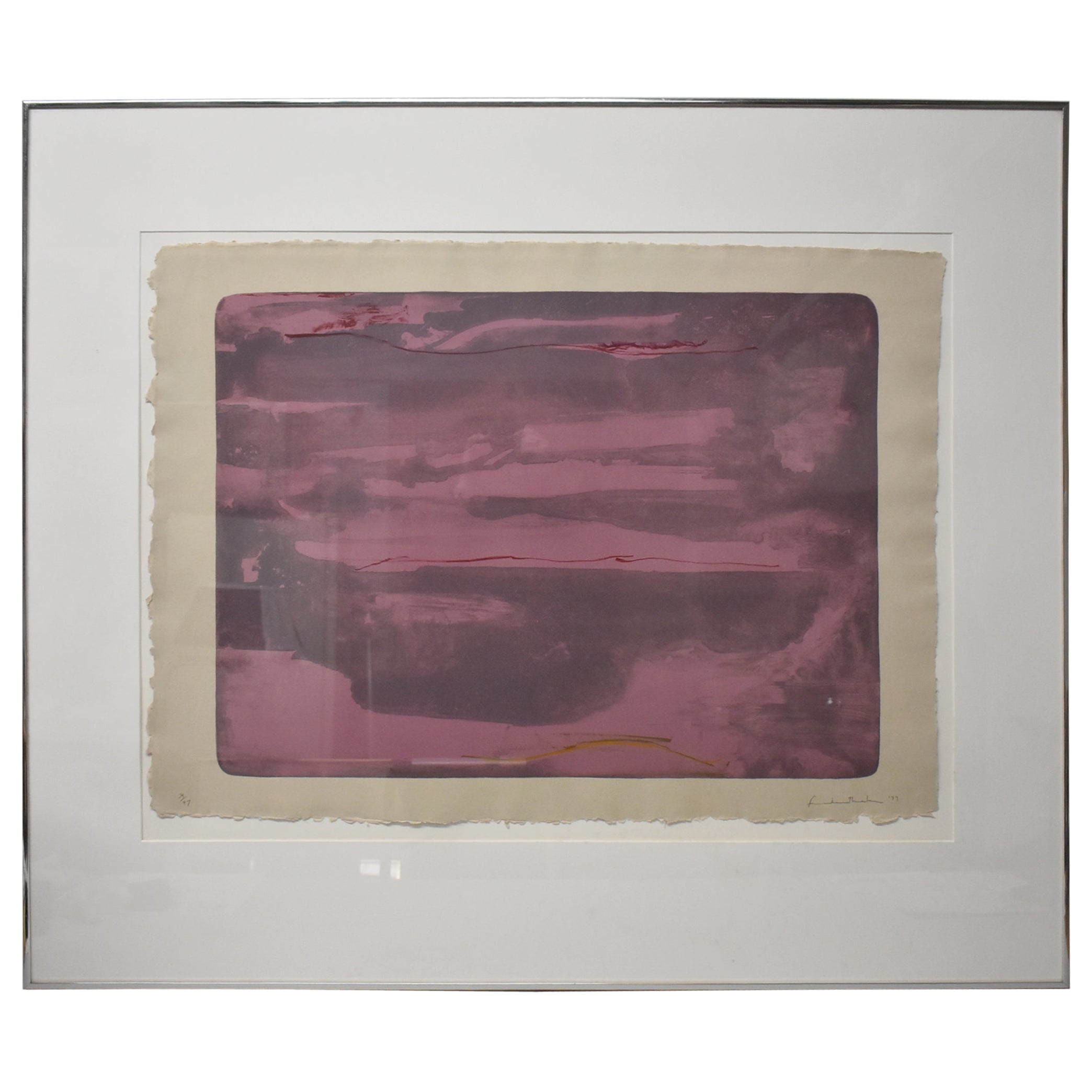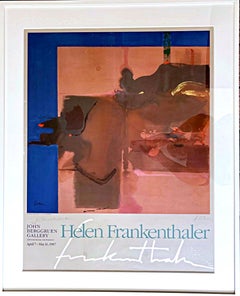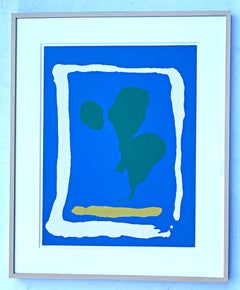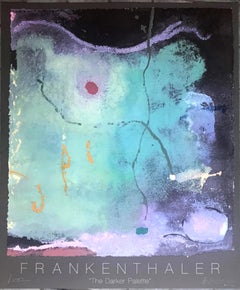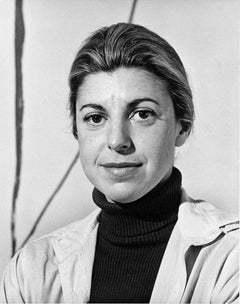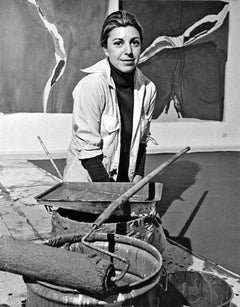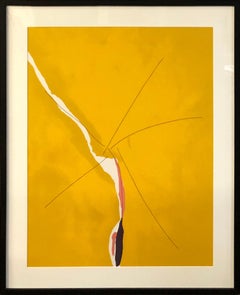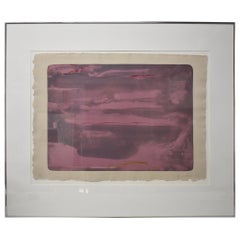Items Similar to Photographic print, hand signed and inscribed by Helen Frankenthaler, framed
Want more images or videos?
Request additional images or videos from the seller
1 of 9
Photographic print, hand signed and inscribed by Helen Frankenthaler, framedca. 1987
ca. 1987
$2,800
£2,157.32
€2,464.33
CA$4,008.69
A$4,372.28
CHF 2,298.91
MX$52,469.32
NOK 29,026.19
SEK 27,073.51
DKK 18,404.96
About the Item
Helen Frankenthaler
Hand signed and inscribed photograph, ca. 1987
Photograph printed on offset lithograph
Hand signed and inscribed by Helen Frankenthaler on the front
Frame Included: This work is elegantly floated and framed in a white wood frame with UV plexiglass..
We don't know who took the original photograph of Helen Frankenthaler - hence the designation "after" for the image itself, but this offset print of the original photgraph is indeed hand signed and inscribed by Helen Frankenthaler herself.
Measurements:
Frame:
17.25 x 15 x 1.5 inches
Photo:
12 x 9.5 inches
- Creation Year:ca. 1987
- Dimensions:Height: 17.25 in (43.82 cm)Width: 15 in (38.1 cm)Depth: 1.5 in (3.81 cm)
- Medium:
- Movement & Style:
- After:Helen Frankenthaler (1928, American)
- Period:
- Condition:
- Gallery Location:New York, NY
- Reference Number:1stDibs: LU1745215092762
About the Seller
5.0
Platinum Seller
Premium sellers with a 4.7+ rating and 24-hour response times
Established in 2007
1stDibs seller since 2022
465 sales on 1stDibs
Typical response time: 1 hour
- ShippingRetrieving quote...Shipping from: New York, NY
- Return Policy
More From This Seller
View AllHand signed letter from Frankenthaler framed with Arkatov's signed portrait
By Helen Frankenthaler
Located in New York, NY
This work features a photographic portrait of Helen Frankenthaler, taken by renowned musician and photographer Jim Arkatov, founder of the Los Angeles Chamber Orchester, and author of the 1998 book "The Creative Personality".
The photograph is hand signed and dated '92 by Jim Arkatov. Framed alongside the photograph is a typed letter, hand signed in marker with a personal annotation ("Thanks again!!") by Helen Frankenthaler, thanking Mr. Arkatov for sending her glossy prints of his photograph and stating that she looks forward to seeing his book.
Arkatov's original signed portrait, along with Frankenthaler's original signed letter, are elegantly framed in a museum quality wood frame under UV plexiglass. There is also a die-cut window in the back of the frame to reveal Arkatov's signature on the back of his photograph.
Measurements:
Framed
14.25 inches (vertical) by 19.75 inches (horizontal) by 1.75 inches (depth)
Photographic portrait of Helen Frankenthaler:
9.25 inches (vertical) by 7.25 inches (horizontal)
Letter from Frankenthaler to Arkatov:
7 inches (vertical) by 6.25 inches (horizontal)
This collection was acquired from the Estate of Jim Arkatov. Below is an excerpt from his 2019 obituary in the Los Angeles Times:
"...His was an immigrant’s story, a child from Russia who landed in San Francisco, befriended violinist Isaac Stern — whose fame was still to come — took up the cello and decided to pour his life into making music.
James Arkatov found work with the Pittsburgh Symphony Orchestra and then with the philharmonic in San Francisco before coming to L.A. as a Hollywood studio musician who worked on movie soundtracks and backed up Ella Fitzgerald on some of her more memorable recordings, such as “Ella Fitzgerald Sings the George and Ira Gershwin Song Books.”
Amazed at the dazzling talent around him in Hollywood, he came up with a simple but lasting idea — form their own orchestra. The Los Angeles Chamber Orchestra made its debut on an April evening in 1968, as hundreds squeezed into the newly built Mark Taper Forum. Arkatov played cello as usual as the ensemble drifted through the works of Mozart, Vivaldi, Haydn and other legends of the classics who’d written music specially for smaller orchestras.
Arkatov, who lived long enough to see the orchestra celebrate its 50th anniversary, died Saturday at his home in Los Angeles. He was 98.
“The orchestra represented a contextualized part of L.A. that had simply never been captured,” said his son, Alan Arkatov, the chair of the education and technology program at USC’s Rossier School of Education. “L.A. simply didn’t have this type of ensemble.” Arkatov was born in Odessa, Russia, on July 17, 1920, and moved around Europe before sailing with his family to San Francisco, where his father opened a photo studio. One of his early childhood friends was Stern, who would become an international star who performed on the world’s biggest stages. Arkatov, who began playing the cello when he was 9, formed a string quartet with Stern when they were teens.
After stints as a cellist in San Francisco, Pittsburgh and Indianapolis, Arkatov became a member of the NBC Orchestra, the studio musicians who supplied the soundtracks for the movies that kept Hollywood humming.
Pulling from the talent of Hollywood like an NFL team on draft day, he cobbled together a roster capable of handling the delicate and nuanced music written for chamber orchestras. In contrast to the L.A. Phil, which filled the stage with 100 or so musicians, the chamber orchestra was but half that size. The idea was to create a group that would play works written expressly for such an orchestra, many of them from the Baroque era.
“The ensemble was never meant to compete with the Philharmonic,” Arkatov’s son said...."
Helen Frankenthaler Biography:
Helen Frankenthaler (1928-2011), whose career spanned six decades, has long been recognized as one of the great American artists of the twentieth century. She was eminent among the second generation of postwar American abstract painters and is widely credited for playing a pivotal role in the transition from Abstract Expressionism to Color Field painting. Through her invention of the soak-stain technique, she expanded the possibilities of abstract painting, while at times referencing figuration and landscape in unique ways. She produced a body of work whose impact on contemporary art has been profound and continues to grow.
Frankenthaler was born on December 12, 1928, and raised in New York City. She attended the Dalton School, where she received her earliest art instruction from Rufino Tamayo. In 1949 she graduated from Bennington College, Vermont, where she was a student of Paul Feeley. She later studied briefly with Hans Hofmann.
Frankenthaler’s professional exhibition career began in 1950, when Adolph Gottlieb selected her painting Beach (1950) for inclusion in the exhibition titled Fifteen Unknowns: Selected by Artists of the Kootz Gallery. Her first solo exhibition was presented in 1951, at New York’s Tibor de Nagy Gallery, and that year she was also included in the landmark exhibition 9th St. Exhibition of Paintings and Sculpture.
In 1952 Frankenthaler created Mountains and Sea, a breakthrough painting of American abstraction for which she poured thinned paint directly onto raw, unprimed canvas laid on the studio floor, working from all sides to create floating fields of translucent color. Mountains and Sea was immediately influential for the artists who formed the Color Field school of painting, notable among them Morris Louis and Kenneth Noland.
As early as 1959, Frankenthaler began to be a regular presence in major international exhibitions. She won first prize at the Premiere Biennale de Paris that year, and in 1966 she represented the United States in the 33rd Venice Biennale, alongside Ellsworth Kelly, Roy Lichtenstein, and Jules Olitski. She had her first major museum exhibition in 1960, at New York’s Jewish Museum, and her second, in 1969, at the Whitney Museum of American Art, followed by an international tour.
Frankenthaler experimented tirelessly throughout her long career. In addition to producing unique paintings on canvas and paper, she worked in a wide range of media, including ceramics, sculpture, tapestry, and especially printmaking. Hers was a significant voice in the mid-century “print renaissance” among American abstract painters, and she is particularly renowned for her woodcuts. She continued working productively through the opening years of this century.
Frankenthaler’s distinguished, prolific career has been the subject of numerous monographic museum exhibitions. The Jewish Museum and Whitney Museum shows were succeeded by a major retrospective initiated by the Modern Art Museum of Fort Worth that traveled to The Museum of Modern Art, New York, the Los Angeles County Museum of Art, and the Detroit Institute of Arts, MI (1989); and those devoted to works on paper and prints organized by the National Gallery of Art, Washington, D.C. (1993), among others.
Select recent important exhibitions have included Painted on 21st Street: Helen Frankenthaler from 1950 to 1959 (Gagosian, NY, 2013); Making Painting: Helen Frankenthaler and JMW Turner (Turner Contemporary, Margate, UK, 2014); Giving Up One’s Mark: Helen Frankenthaler in the 1960s and 1970s (Albright-Knox Art Gallery, Buffalo, NY, 2014–15); Pretty Raw: After and Around Helen Frankenthaler (Rose Art Museum, Brandeis University, Waltham, MA, 2015); As in Nature: Helen Frankenthaler, Paintings and No Rules: Helen Frankenthaler Woodcuts...
Category
1990s Contemporary Black and White Photography
Materials
Ink, Photographic Paper, Rag Paper
Abstract Expressionist Poster (Hand signed and inscribed by Helen Frankenthaler)
By Helen Frankenthaler
Located in New York, NY
Helen Frankenthaler (after)
Frankenthaler (autographedand inscribed), 1988
Offset lithograph poster (hand signed and inscribed to renowned collectors)
Hand signed and warmly inscribed in ink on the front
Frame included: Museum frame with UV plexiglass included
Inscribed "to Paul and Joan, love Helen Frankenthaler" (Paul and Joan Gluck were major art collectors)
Measurements:
Framed
42 inches vertical by 34 inches by 1.75 inches
Print
34.5 inches vertical by 27 inches
Helen Frankenthaler, A Brief Biography
Helen Frankenthaler (1928-2011), whose career spanned six decades, has long been recognized as one of the great American artists of the twentieth century. She was eminent among the second generation of postwar American abstract painters and is widely credited for playing a pivotal role in the transition from Abstract Expressionism to Color Field painting. Through her invention of the soak-stain technique, she expanded the possibilities of abstract painting, while at times referencing figuration and landscape in unique ways. She produced a body of work whose impact on contemporary art has been profound and continues to grow.
Frankenthaler was born on December 12, 1928, and raised in New York City. She attended the Dalton School, where she received her earliest art instruction from Rufino Tamayo. In 1949 she graduated from Bennington College, Vermont, where she was a student of Paul Feeley. She later studied briefly with Hans Hofmann
Frankenthaler’s professional exhibition career began in 1950, when Adolph Gottlieb selected her painting Beach (1950) for inclusion in the exhibition titled Fifteen Unknowns: Selected by Artists of the Kootz Gallery. Her first solo exhibition was presented in 1951, at New York’s Tibor de Nagy Gallery, and that year she was also included in the landmark exhibition 9th St. Exhibition of Paintings and Sculpture.
In 1952 Frankenthaler created Mountains and Sea, a breakthrough painting of American abstraction for which she poured thinned paint directly onto raw, unprimed canvas laid on the studio floor, working from all sides to create floating fields of translucent color. Mountains and Sea was immediately influential for the artists who formed the Color Field school of painting, notable among them Morris Louis and Kenneth Noland.
As early as 1959, Frankenthaler began to be a regular presence in major international exhibitions. She won first prize at the Premiere Biennale de Paris that year, and in 1966 she represented the United States in the 33rd Venice Biennale, alongside Ellsworth Kelly, Roy Lichtenstein, and Jules Olitski. She had her first major museum exhibition in 1960, at New York’s Jewish Museum, and her second, in 1969, at the Whitney Museum of American Art, followed by an international tour.
Frankenthaler experimented tirelessly throughout her long career. In addition to producing unique paintings on canvas and paper, she worked in a wide range of media, including ceramics, sculpture, tapestry, and especially printmaking. Hers was a significant voice in the mid-century “print renaissance” among American abstract painters, and she is particularly renowned for her woodcuts. She continued working productively through the opening years of this century.
Frankenthaler’s distinguished, prolific career has been the subject of numerous monographic museum exhibitions. The Jewish Museum and Whitney Museum shows were succeeded by a major retrospective initiated by the Modern Art Museum of Fort Worth that traveled to The Museum of Modern Art, New York, the Los Angeles County Museum of Art, and the Detroit Institute of Arts, MI (1989); and those devoted to works on paper and prints organized by the National Gallery of Art, Washington, D.C. (1993), among others.
Select recent important exhibitions have included Painted on 21st Street: Helen Frankenthaler from 1950 to 1959 (Gagosian, NY, 2013); Making Painting: Helen Frankenthaler and JMW Turner (Turner Contemporary, Margate, UK, 2014); Giving Up One’s Mark: Helen Frankenthaler in the 1960s and 1970s (Albright-Knox Art Gallery, Buffalo, NY, 2014–15); Pretty Raw: After and Around Helen Frankenthaler (Rose Art Museum, Brandeis University, Waltham, MA, 2015); As in Nature: Helen Frankenthaler, Paintings and No Rules: Helen Frankenthaler Woodcuts...
Category
1980s Abstract Abstract Prints
Materials
Offset
Helen Frankenthaler, Air Frame (Harrison 6) her first silkscreen Signed AP 1965
By Helen Frankenthaler
Located in New York, NY
Helen Frankenthaler
Air Frame, from the New York Ten portfolio (Harrison 6), 1965
Color silkscreen on Arches double-weight watercolor paper
Signed and annotated AP in graphite on the front; this is an Artist's Proof, aside from the regular edition of 200
“What concerns me when I work is not whether a picture is a landscape… or whether somebody will see a sunset in it. What concerns me is, did I make a beautiful picture?” - - Helen Frankenthaler
Pencil signed AP, one of 25 proofs aside from the regular edition of 200
Catalogue Raisonne: Harrison 6, Berggruen 7, Clark 6
Printed by Chiron Press, New York. Published by Tanglewood Press, New York.
This work has been newly framed in a museum quality wood frame under UV plexiglass. The original label from the famed John Berggruen Gallery in California has been affixed to the back to preserve provenance.
Other examples of this coveted 1965 work can be found in major institutional and museum collections worldwide.
Measurements:
Framed
29 inches vertical by 24 inches (horizontal) by 1.5 inches
Artwork:
22 inches vertical x 17 inches horizontal
This is Frankenthaler's first silkscreen, produced for the portfolio New York Ten, which includes works by other New York-based artists at the time such as Roy Lichtenstein, Jim Dine, Tom Wesselmann and Claes Oldenburg. (She created her first lithograph in 1961)
Other examples of this edition are found in the permanent collections of the Museum of Modern Art, MOCA Chicago, the Metropolitan Museum, the Philadelphia Museum, the Art Institute of Chicago, and numerous regional museums and institutions in the United States and worldwide.
Helen Frankenthaler, A Brief Biography
Helen Frankenthaler (1928-2011), whose career spanned six decades, has long been recognized as one of the great American artists of the twentieth century. She was eminent among the second generation of postwar American abstract painters and is widely credited for playing a pivotal role in the transition from Abstract Expressionism to Color Field painting. Through her invention of the soak-stain technique, she expanded the possibilities of abstract painting, while at times referencing figuration and landscape in unique ways. She produced a body of work whose impact on contemporary art has been profound and continues to grow.
Frankenthaler was born on December 12, 1928, and raised in New York City. She attended the Dalton School, where she received her earliest art instruction from Rufino Tamayo. In 1949 she graduated from Bennington College, Vermont, where she was a student of Paul Feeley. She later studied briefly with Hans Hofmann.
Frankenthaler’s professional exhibition career began in 1950, when Adolph Gottlieb selected her painting Beach (1950) for inclusion in the exhibition titled Fifteen Unknowns: Selected by Artists of the Kootz Gallery. Her first solo exhibition was presented in 1951, at New York’s Tibor de Nagy Gallery, and that year she was also included in the landmark exhibition 9th St. Exhibition of Paintings and Sculpture.
In 1952 Frankenthaler created Mountains and Sea, a breakthrough painting of American abstraction for which she poured thinned paint directly onto raw, unprimed canvas laid on the studio floor, working from all sides to create floating fields of translucent color. Mountains and Sea was immediately influential for the artists who formed the Color Field school of painting, notable among them Morris Louis and Kenneth Noland.
As early as 1959, Frankenthaler began to be a regular presence in major international exhibitions. She won first prize at the Premiere Biennale de Paris that year, and in 1966 she represented the United States in the 33rd Venice Biennale, alongside Ellsworth Kelly, Roy Lichtenstein, and Jules Olitski. She had her first major museum exhibition in 1960, at New York’s Jewish Museum, and her second, in 1969, at the Whitney Museum of American Art, followed by an international tour.
Frankenthaler experimented tirelessly throughout her long career. In addition to producing unique paintings on canvas and paper, she worked in a wide range of media, including ceramics, sculpture, tapestry, and especially printmaking. Hers was a significant voice in the mid-century “print renaissance” among American abstract painters, and she is particularly renowned for her woodcuts. She continued working productively through the opening years of this century.
Frankenthaler’s distinguished, prolific career has been the subject of numerous monographic museum exhibitions. The Jewish Museum and Whitney Museum shows were succeeded by a major retrospective initiated by the Modern Art Museum of Fort Worth that traveled to The Museum of Modern Art, New York, the Los Angeles County Museum of Art, and the Detroit Institute of Arts, MI (1989); and those devoted to works on paper and prints organized by the National Gallery of Art, Washington, D.C. (1993), among others.
Select recent important exhibitions have included Painted on 21st Street: Helen Frankenthaler from 1950 to 1959 (Gagosian, NY, 2013); Making Painting: Helen Frankenthaler and JMW Turner (Turner Contemporary, Margate, UK, 2014); Giving Up One’s Mark: Helen Frankenthaler in the 1960s and 1970s (Albright-Knox Art Gallery, Buffalo, NY, 2014–15); Pretty Raw: After and Around Helen Frankenthaler (Rose Art Museum, Brandeis University, Waltham, MA, 2015); As in Nature: Helen Frankenthaler, Paintings and No Rules: Helen Frankenthaler Woodcuts...
Category
1960s Abstract Expressionist Abstract Prints
Materials
Screen
The Darker Palette print, Hand signed twice and inscribed by Helen Frankenthaler
By Helen Frankenthaler
Located in New York, NY
Helen Frankenthaler (after)
Frankenthaler: The Darker Palette (autographed and inscribed), 1998
Offset Lithograph print
42 × 35 in
hand signed "Frankenthaler" lower left; inscribed a...
Category
1990s Abstract Expressionist Abstract Prints
Materials
Offset, Lithograph
A Paintings Retrospective: vintage LACMA Museum poster depicting her 1963 work
By Helen Frankenthaler
Located in New York, NY
Helen Frankenthaler (after)
A Paintings Retrospective: vintage LACMA Museum poster, 1990
Offset lithograph museum poster
(Unsigned & Unnumbered)
37 × 25 inches
Unframed
This was printed in the artists lifetime - making it more collectible - on the occasion of the exhibition, "Helen Frankenthaler: A Paintings Retrospective from February to April, 1990 at the Los Angeles County Museum of Art (LACMA)
Print is published by Editions Limited Galleries, San Francisco for Los Angeles County Museum of Art (LACMA), LA, CA
The work depicted is Helen Frankenthaler, The Bay, 1963, acrylic on canvas, Detroit Institute of Arts, Michigan (Incidentally, this beautiful work is featured on the cover of the book Water and Art' by David Clarke.)
“What concerns me when I work is not whether a picture is a landscape… or whether somebody will see a sunset in it. What concerns me is, did I make a beautiful picture?” - - Helen Frankenthaler
This is Frankenthaler's first silkscreen, produced for the portfolio New York Ten, which includes works by other New York-based artists at the time such as Roy Lichtenstein, Jim Dine, Tom Wesselmann and Claes Oldenburg. (She created her first lithograph in 1961)
Other examples of this edition are found in the permanent collections of the Museum of Modern Art, MOCA Chicago, the Metropolitan Museum, the Philadelphia Museum, the Art Institute of Chicago, and numerous regional museums and institutions in the United States and worldwide.
Helen Frankenthaler, A Brief Biography
Helen Frankenthaler (1928-2011), whose career spanned six decades, has long been recognized as one of the great American artists of the twentieth century. She was eminent among the second generation of postwar American abstract painters and is widely credited for playing a pivotal role in the transition from Abstract Expressionism to Color Field painting. Through her invention of the soak-stain technique, she expanded the possibilities of abstract painting, while at times referencing figuration and landscape in unique ways. She produced a body of work whose impact on contemporary art has been profound and continues to grow.
Frankenthaler was born on December 12, 1928, and raised in New York City. She attended the Dalton School, where she received her earliest art instruction from Rufino Tamayo. In 1949 she graduated from Bennington College, Vermont, where she was a student of Paul Feeley. She later studied briefly with Hans Hofmann.
Frankenthaler’s professional exhibition career began in 1950, when Adolph Gottlieb selected her painting Beach (1950) for inclusion in the exhibition titled Fifteen Unknowns: Selected by Artists of the Kootz Gallery. Her first solo exhibition was presented in 1951, at New York’s Tibor de Nagy Gallery, and that year she was also included in the landmark exhibition 9th St. Exhibition of Paintings and Sculpture.
In 1952 Frankenthaler created Mountains and Sea, a breakthrough painting of American abstraction for which she poured thinned paint directly onto raw, unprimed canvas laid on the studio floor, working from all sides to create floating fields of translucent color. Mountains and Sea was immediately influential for the artists who formed the Color Field school of painting, notable among them Morris Louis and Kenneth Noland.
As early as 1959, Frankenthaler began to be a regular presence in major international exhibitions. She won first prize at the Premiere Biennale de Paris that year, and in 1966 she represented the United States in the 33rd Venice Biennale, alongside Ellsworth Kelly, Roy Lichtenstein, and Jules Olitski. She had her first major museum exhibition in 1960, at New York’s Jewish Museum, and her second, in 1969, at the Whitney Museum of American Art, followed by an international tour.
Frankenthaler experimented tirelessly throughout her long career. In addition to producing unique paintings on canvas and paper, she worked in a wide range of media, including ceramics, sculpture, tapestry, and especially printmaking. Hers was a significant voice in the mid-century “print renaissance” among American abstract painters, and she is particularly renowned for her woodcuts. She continued working productively through the opening years of this century.
Frankenthaler’s distinguished, prolific career has been the subject of numerous monographic museum exhibitions. The Jewish Museum and Whitney Museum shows were succeeded by a major retrospective initiated by the Modern Art Museum of Fort Worth that traveled to The Museum of Modern Art, New York, the Los Angeles County Museum of Art, and the Detroit Institute of Arts, MI (1989); and those devoted to works on paper and prints organized by the National Gallery of Art, Washington, D.C. (1993), among others.
Select recent important exhibitions have included Painted on 21st Street: Helen Frankenthaler from 1950 to 1959 (Gagosian, NY, 2013); Making Painting: Helen Frankenthaler and JMW Turner (Turner Contemporary, Margate, UK, 2014); Giving Up One’s Mark: Helen Frankenthaler in the 1960s and 1970s (Albright-Knox Art Gallery, Buffalo, NY, 2014–15); Pretty Raw: After and Around Helen Frankenthaler (Rose Art Museum, Brandeis University, Waltham, MA, 2015); As in Nature: Helen Frankenthaler, Paintings and No Rules: Helen Frankenthaler Woodcuts...
Category
1990s Abstract Expressionist Abstract Prints
Materials
Offset, Lithograph
Book: Works on Paper 1949-1984 (Hand signed & inscribed by Helen Frankenthaler)
By Helen Frankenthaler
Located in New York, NY
Helen Frankenthaler (after)
Frankenthaler, Works on Paper 1949-1984 (Hand signed and inscribed to Dick Polich, Founder of Tallix Foundry), 1986
Softcover monograph (book), hand signe...
Category
1980s Abstract Expressionist More Art
Materials
Offset
You May Also Like
Artist Helen Frankenthaler, signed by Jack Mitchell
By Jack Mitchell
Located in Senoia, GA
11 x 14" vintage silver gelatin photograph of artist Helen Frankenthaler in her studio in 1971. Signed on the print verso. Comes directly fr...
Category
1970s Pop Art Black and White Photography
Materials
Silver Gelatin
$1,800 Sale Price
40% Off
Artist Helen Frankenthaler with her recent work, signed by Jack Mitchell
By Jack Mitchell
Located in Senoia, GA
11 x 14" vintage silver gelatin photograph of famed painter Helen Frankenthaler in her Manhattan studio with recent work, 1971. Signed by Jack Mitchell on the print verso. Comes dire...
Category
1970s Pop Art Black and White Photography
Materials
Silver Gelatin
$1,875 Sale Price
25% Off
Helen Frankenthaler 'Sesame' Vintage
By Helen Frankenthaler
Located in Brooklyn, NY
Silkscreen poster featuring Helen Frankenthaler’s Sesame, showcasing her expressive use of color and fluid form that helped define postwar American abstraction. The artwork is presen...
Category
1990s American Modern Prints and Multiples
Materials
Screen
Helen Frankenthaler "Dream Walk" Lithograph, Signed and Numbered 39/47
By Helen Frankenthaler
Located in Toledo, OH
Helen Frankenthaler (1928-2011)
Six color lithograph, Dream Walk, 1977. Number 39 from an edition of 47, pencil lower left corner. Signed and dated 1977 in pencil in lower right cor...
Category
Vintage 1970s American Mid-Century Modern Prints
Materials
Paper
Helen Frankenthaler Female Abstract Art 1968
By Helen Frankenthaler
Located in grand Lancy, CH
Helen Frankenthaler Female Abstract Art poster 1968
Category
Vintage 1960s American Posters
Materials
Glass, Wood, Paper
Helen Frankenthaler Color Etching
By Helen Frankenthaler
Located in West Palm Beach, FL
Ganymede, 1978
Etching with aquatint
9/49
Pencil signed and dated by the artist.
Category
Vintage 1970s North American Contemporary Art
Materials
Paper
More Ways To Browse
Otis Kwame Kye Quaicoe
Pablo Picasso Carmen Square Man
Picasso Smiling
Romare Bearden Collage Prints
Rose Wylie
Roy Fairchild Framed
Samuel Cousins
Sawyer Lithograph
Vintage Vogue Prints
Vladimir Tretchikoff
Vote Mcgovern
Warhol Indian Series
Warhol Ingrid
Wesselmann Vivienne
Ai Weiwei Guardian
Alex Katz Nicole
Andy Warhol Albert Einstein
Andy Warhol Einstein

